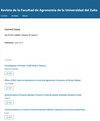Residues and dissipation of imidacloprid in avocado fruit
IF 0.5
4区 农林科学
Q4 AGRONOMY
Revista De La Facultad De Agronomia De La Universidad Del Zulia
Pub Date : 2022-12-26
DOI:10.47280/revfacagron(luz).v40.n1.04
引用次数: 0
Abstract
Imidacloprid is a neonicotinoid insecticide used to control insect pests in avocado (Persea americana); its excessive application could generate residues above the maximum residue limits (MRL) in the fruit, causing a serious health risk to consumers. The objective of this work was to determine the residues and dissipation of imidacloprid in avocado fruit, Hass variety. The treatments were the doses of Imidacloprid (0.5, 1.0 and 1.5 mL.L-1) under the commercial formulation Thunder 350SC and the forms of application (sprayed to foliage and drip at the foot of the plant). There were six treatments in a completely randomized experimental design with three replications and 18 experimental units (plants). Quantification was by HPLC (QuEChERS). The evaluations were carried out on two matrices (avocado fruit peel and pulp) at 1, 3, 7 and 14 days after the application of Imidacloprid. The application of the 0.5 mL.L-1 dose by drip at the foot of the plant resulted in lower residual and a higher percentage of dissipation in both matrices, higher daily dissipation rate in the pulp, with imidacloprid concentrations that did not exceed the MRL (0.7 mg.kg-1). The application of 1.5 mL.L-1 by spraying resulted in higher residual, and in a lower percentage of dissipation in both matrices, with imidacloprid concentrations in the peel exceeding the MRL at 7 and 14 days. In the pulp, none of the treatments exceeded the MRL.吡虫啉在鳄梨果实中的残留与耗散
吡虫啉是一种用于防治鳄梨(Persea americana)害虫的新烟碱类杀虫剂;过量使用会在水果中产生超过最大残留限量(MRL)的残留物,对消费者造成严重的健康风险。本研究旨在测定吡虫啉在哈斯牛油果中的残留量和耗散量。试验采用雷350SC商业配方吡虫啉0.5、1.0和1.5 mL.L-1的剂量和喷施方式(喷施于叶片和滴施于植株根部)。6个处理采用完全随机试验设计,3个重复,18个试验单位(株)。采用高效液相色谱法(QuEChERS)定量。分别于吡虫啉给药后1、3、7和14 d对牛油果果皮和果肉进行评价。在植株根部滴注0.5 mL.L-1剂量的吡虫啉,两种基质的残留较低,耗散率较高,浆中的日耗散率较高,且吡虫啉浓度不超过最大剂量(0.7 mg.kg-1)。喷施1.5 mL.L-1的吡虫啉残留量较高,两种基质的耗散率较低,果皮中吡虫啉浓度在第7天和第14天超过了最大残留量。在牙髓中,没有任何一种处理超过MRL。
本文章由计算机程序翻译,如有差异,请以英文原文为准。
求助全文
约1分钟内获得全文
求助全文
来源期刊
CiteScore
0.50
自引率
0.00%
发文量
45
审稿时长
>12 weeks
期刊介绍:
La Revista de la Facultad de Agronomía de la Universidad del Zulia publica artículos científicos, notas técnicas, comunicaciones rápidas y artículos invitados originales e inéditos, es decir, que no hayan sido publicados ni enviados simultáneamente a otra revista para su publicación, de autores interesados en el campo agrícola vegetal y agrícola animal. De presentarse el caso que el autor o autores hubiesen enviado o publicado su manuscrito simultáneamente en otra revista, podrán ser sancionados con la no publicación en esta revista por tiempo indefinido.
Se admiten manuscritos escritos en idioma Español, Portugués o Inglés, con un resumen en Español o Portugués y otro en Inglés (Abstract).

 求助内容:
求助内容: 应助结果提醒方式:
应助结果提醒方式:


